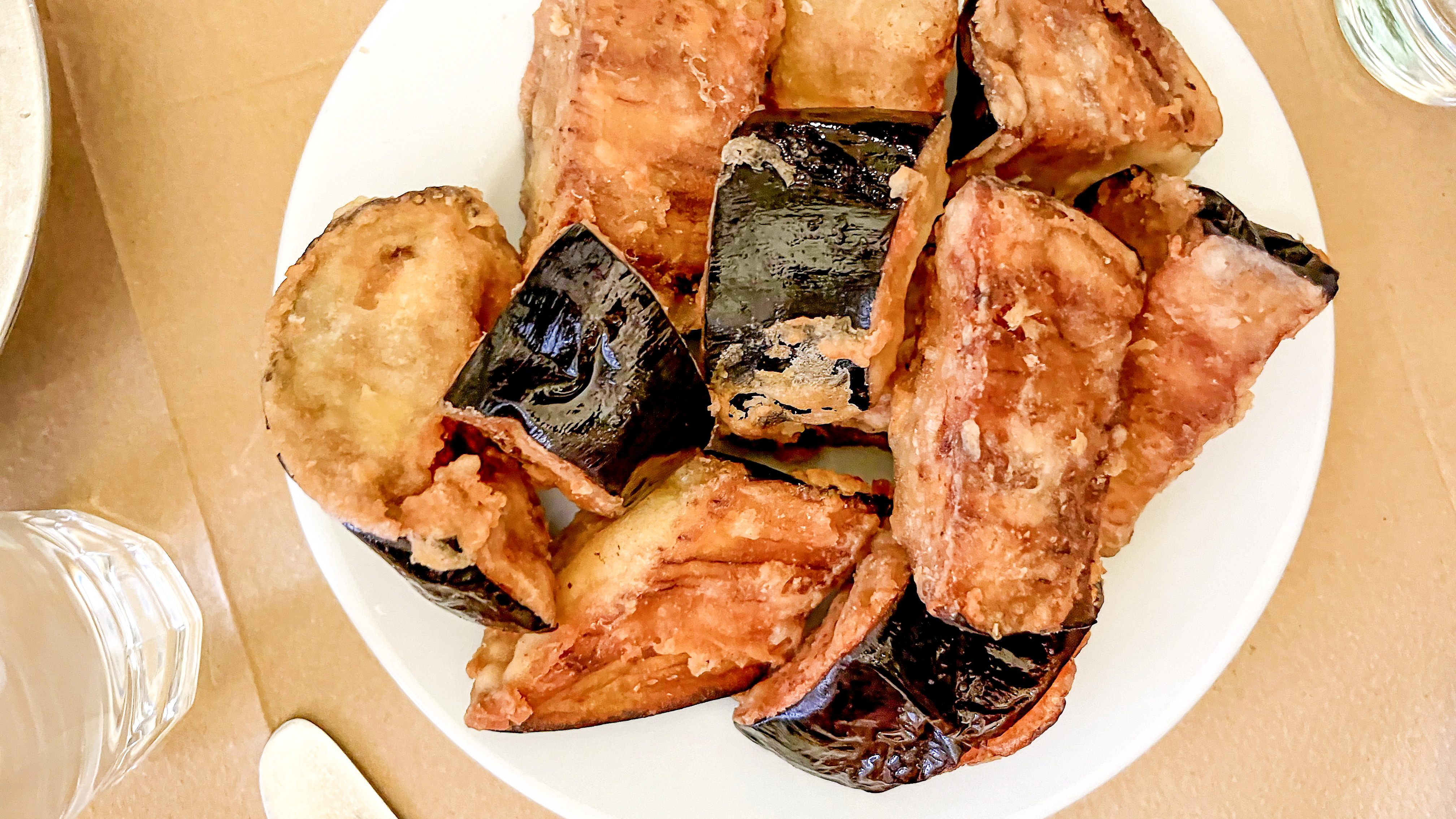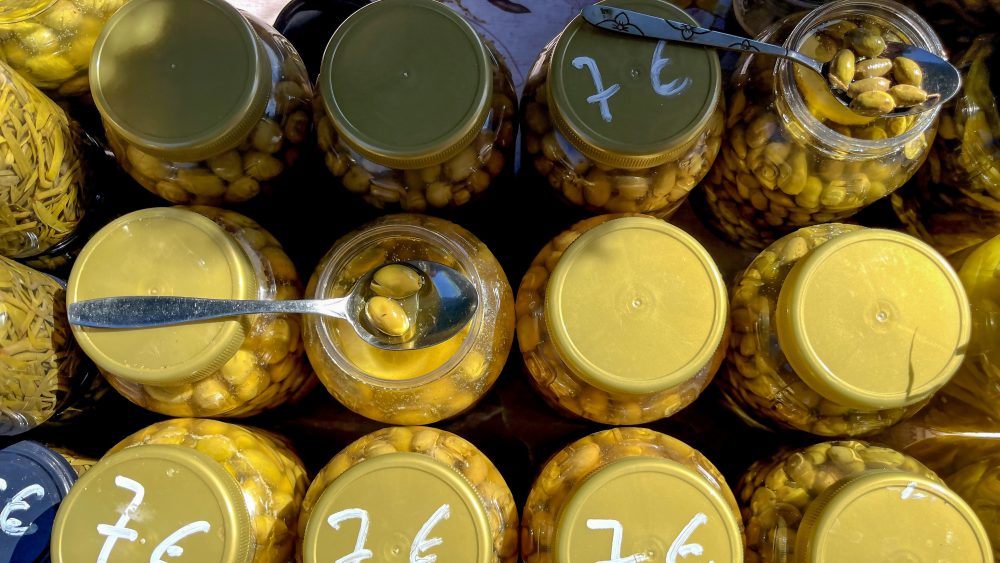
For a fully immersive education, you can travel with us to Greece, where you’ll visit a small family-run olive grove with cookbook author and chef Carolina Doriti. You can reserve your spot now, but in the meantime, Doriti was able to hop on a call and share some tips. Her book, “Salt of the Earth” is a joyous celebration of the food and flavors of Greece that’s packed with recipes for making the most of the flavorful fat, but she also has plenty of easy, everyday suggestions for getting the most out of your bottle of EVOO.
You can deep fry in olive oil
It’s a common misconception that you can’t fry in olive oil. “People in America think that if you use olive oil and you cook with it, you ruin it,” said Doriti. “And usually, even Greek people do this—usually they would use a cheaper type of olive oil for their cooking and then use a better one for raw [applications]. [But] a good olive oil, an extra virgin olive oil, the higher quality has the lowest acidity level and a higher smoke point. You can even cook at 180-200 degrees Celsius, which is where you want to fry. But with the olive oils that are not extra virgin? No, because these are gonna burn much faster, and then it's going to taste bad.”
The main thing preventing Americans from deep frying in olive oil? Cost. After all, the country is one of the top-three olive oil producers, along with Spain and Italy, which keeps the prices down. “Olive oil in Greece is much cheaper than what people get in the States,” explained Doriti. “Even during times of war, people would have access to olive oil. Some of the poorest recipes have olive oil. If you're in the south, like the area of the Peloponnese, for instance, they bathe in olive oil, they fry in olive oil, they do everything in olive oil.”

If you’re looking to dip your toe into the sizzling vat of olive oil-frying, eggplant—like the one we enjoyed on our most recent culinary tour in Greece—is a good place to start. But before the vegetable sees any oil, a little pre-cooking is necessary. “Eggplant is like a sponge. It reacts as a sponge. It absorbs everything,” said Doriti. “And it can be very greasy. A lot of the time if you go to restaurants and you order fried eggplant, you get a very oily thing, so the best way to prevent that is to blanch the eggplants or soak them in warm water with some salt. Then squeeze out the excess water. You press it, then you fry after it's dry.”
The best breading is the simplest. Doriti recommends “Just flour.” No egg, no bread crumbs, or anything like that. “I mean, you can,” she said. “There are many ways to fry eggplants, but the one that they tried [on the tour] was at a very, very humble place. They just do it very correctly. They cut them thick. And because they blanch them they're super soft inside and then super crispy on the outside. They're amazing.”
You should drizzle olive oil on ice cream
Olive oil may be the salad oil of choice in the States, but it has far sweeter applications in Greece. “I make chocolate mousse with olive oil,” said Doriti. “It's a chocolate mousse with lemon and olive oil. But I drizzle olive oil on top of ice cream, which is amazing—and salt!”
Olive oil may seem like an unusual sundae topping at first, but Doriti has never had any trouble converting people. “When I do tours here, I give it to people. I have an olive oil tasting, and at the end of it I bring ice cream, and they're like, 'What are you doing?' I put salt and olive oil and then you know, people go crazy. They love it.“
And mix it into your smoothies
Just a drizzle of olive oil can give your smoothie a rich, creamy texture. “I do smoothies with olive oil. It's amazing to drink olive oil in the morning,” said Doriti. “You just add a little bit inside. Make a smoothie with any fruit, or cacao is great with olive oil. It doesn't affect the flavor really. But olive oil when you whip it? It makes it creamier. It's a great way to make sure you get your nutrients.”
Olive oil is the key to low-fuss cookies and cakes
Rather than wait for butter to come to room temperature, Doriti uses always-ready olive oil to make cakes and cookies without an electric stand or hand mixer. “I have a reel on my Instagram for cookies made with olive oil,” she said. “You stir the olive oil with the sugar, to make sure it dissolves. It looks weird. If you see it, you're like 'Uh, what is she making?' But then it all comes together. You usually don't use a mixer. I prefer to do it by hand, because it can splatter. But it works really well. You just need to know a few tricks. Also the cake! It's a very traditional cake. They make it for a specific saint—if they lose something they bake this cake and this saint helps you find it. And this is a cake that has magic ingredients that are very symbolic. And it's made with olive oil, spices, flour. Very simple. Super tasty."
And it makes a great steak sauce
Another surprising food you should lavish with olive oil? “A steak,” said Doriti. “Grill it, and when you serve it, drizzle on olive oil. It makes extreme sense. You can add a very spicy olive oil on a steak, the ones that burn you when you try them.”
And hold the lemon. “If you decide to put olive oil on a steak, then you do not touch it with other things,” she said. “You have to taste the flavors of the olive oil and the lemon will cover everything. But if you go to a Greek taverna or a simple eatery, 100% of the time, they're just going serve me with lemon. This is more upscale. It's more like a gourmet thing.”
Join us on the road! Learn more about our culinary trips and sign up here.
Join the conversation on Facebook, Instagram, TikTok and Pinterest.
And if you're looking for more Milk Street, check out our livestream cooking classes with our favorite chefs, home cooks and friends for global recipes, cooking methods and more.








